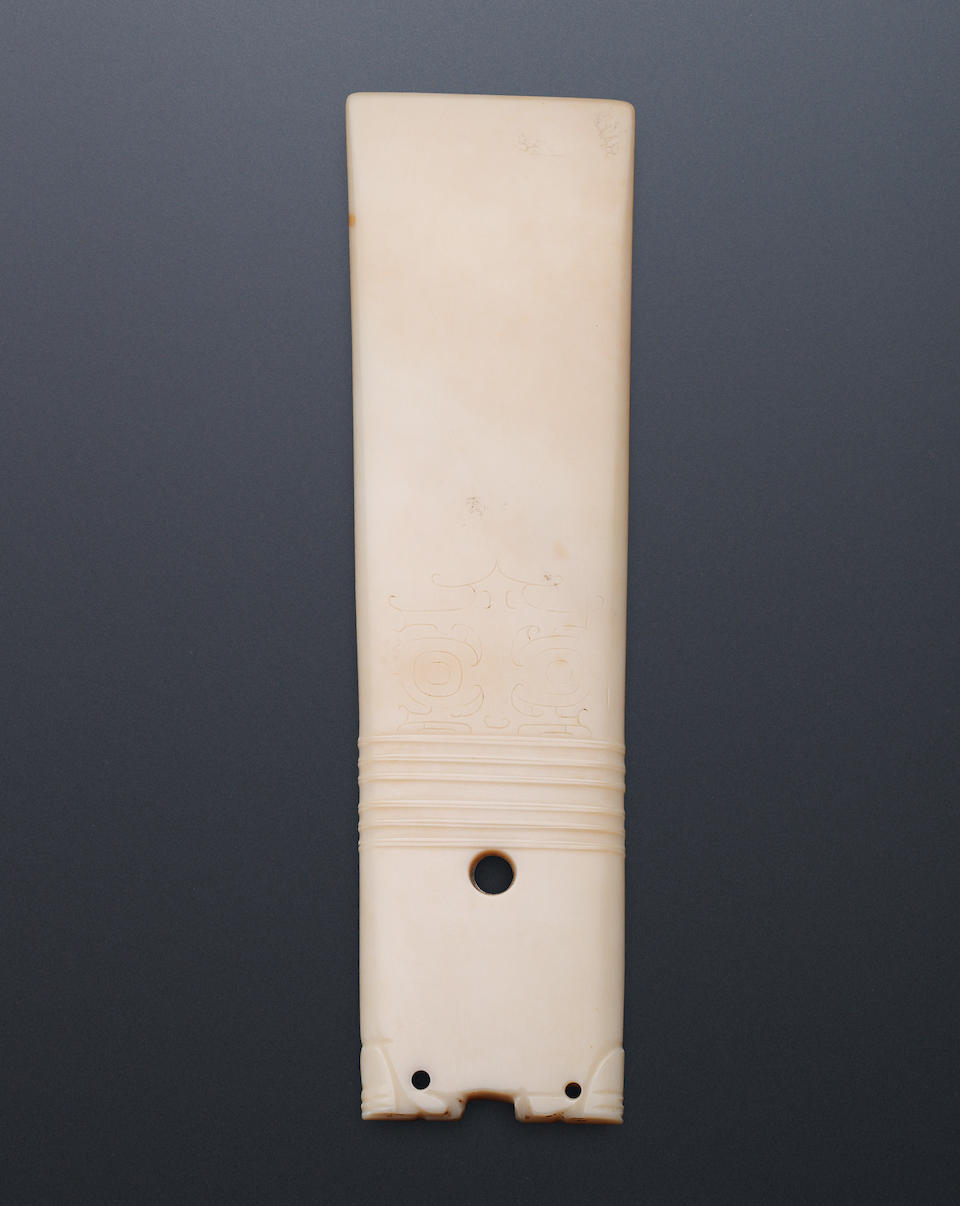A white jade ceremonial blade, gui, Shang Dynasty or later

Lot 9. A white jade ceremonial blade, gui, Shang Dynasty or later; 21.1cm (8 1/4in) long. Estimate HK$ 200,000-300,000. Sold for HK$ 2,680,000 (€ 318,653). Photo: Bonhams.
With sides flared towards the cutting edge, decorated on one side with an incised taotie mask and a bird on the other, below a large hole drilled above six concentric ridges, the top of the butt end carved with a pair of square notches at each side, each notch detailed with cicadas and drilled with two smaller holes, the stone of an opaque pale yellow-white tone.
Note: Administration by rites and ceremonies was a core part of consolidating, legitimising and asserting power under the Shang dynasty's political system. Ritual jades including jade gui ceremonial blades or tablets, qi notched axes and ge halberd blades emerged in addition to the traditional bi and cong, and became important objects in life and death. Gui tablets were held by kings, dukes and princes on ceremonial occasions. Large quantities of jade ritual wares were excavated from the Yin ruins at Anyang, most notably in Fuhao's tomb which included hundreds of different kinds of jade implements including gui tablets.
The present gui is notable for the unusual inclusion of cicada-formed notches. During this period, jade figures of cicadas were sometimes found in the mouths of the dead and cicada motifs were often included in the decoration of ritual bronzes. The insect was used as a symbol of rebirth in the afterlife, as cicadas spend years underground before emerging.
Compare a jade gui of Longshan culture with similarly incised human-mask on one side, currently in the Shandong Provincial Museum; see also another Neolithic period jade gui excavated from an archaeological site of the Zhou dynasty, in Houma City, Shanxi Province, where the similarly incised bird motif was found but believed to be added during the Eastern Zhou period, both illustrated by Gu Fang, The Pictorial Handbook of Ancient Chinese Jades, Beijing, 2007, pp.63 and 223.
Bonhams. The Sze Yuan Tang Collection of Chinese Jades, Hong Kong, 5 April 2016

/https%3A%2F%2Fprofilepics.canalblog.com%2Fprofilepics%2F1%2F0%2F100183.jpg)
/https%3A%2F%2Fstorage.canalblog.com%2F03%2F02%2F119589%2F96711876_o.jpg)
/https%3A%2F%2Fstorage.canalblog.com%2F11%2F31%2F119589%2F94773502_o.jpg)
/https%3A%2F%2Fstorage.canalblog.com%2F20%2F83%2F119589%2F94772815_o.jpg)
/https%3A%2F%2Fstorage.canalblog.com%2F26%2F72%2F119589%2F75604929_o.jpg)
/https%3A%2F%2Fstorage.canalblog.com%2F59%2F60%2F119589%2F26458628_o.jpg)



/image%2F1371349%2F20240406%2Fob_a54acc_435229368-1644755382961141-18285727260.jpg)
/image%2F1371349%2F20240229%2Fob_b1ea4c_429582962-1625285201574826-43586635599.jpg)
/image%2F1371349%2F20240229%2Fob_84bc3b_429558450-1624783464958333-37673404077.jpg)
/http%3A%2F%2Fstorage.canalblog.com%2F36%2F88%2F119589%2F129555285_o.jpg)